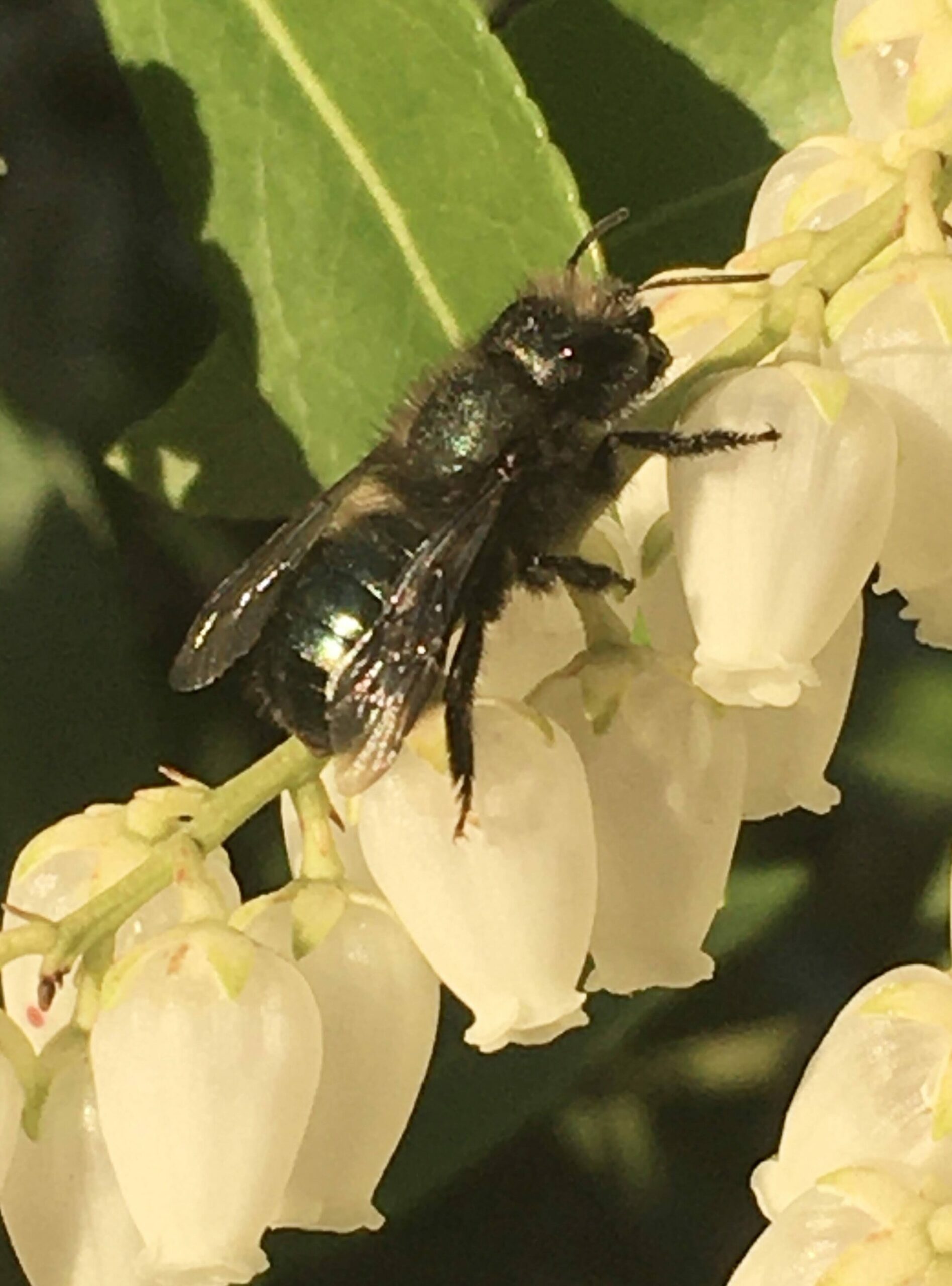It’s early spring and the trees have begun leafing out. Colorful flowers are springing from the ground, and the landscape is slowly coming to life with insect activity. In this post, I’ll highlight some of Oregon’s ubiquitous spring bees, what they are up to, and how to easily recognize them.

Queen bumblebees are emerging from their winter burrows under leaf litter and forest duff. They zoom by with boisterous buzzes. Queen bumblebees are sturdy and furry, and can power through wind, rain and cold better than any other type of bee. Queens are much bigger than the workers that will come once the queens find nest sites and begin laying eggs. For now, they work alone, preparing to lay their first set of worker eggs.
If you see (or hear) any queen bumblebees this spring as they scan the sparsely blooming landscape, they are most likely looking for a proper nest site, finding nectar to energize this search, or, if one has already found her nest, she may be collecting pollen to feed her developing worker offspring.

Mason bees (Osmia lignaria) are a cherished Oregon spring bee active from March to early June. Look closely in a bee hotel for a chance to observe mason bees in action!
Male mason bees emerge first from their pupal cocoons. You might see them patrolling bee hotels waiting for a female to chase down. When the females emerge a little later, they mate and then begin their work provisioning nests with pollen balls and eggs. An individual female has a short lifespan living only about 20 days, but in this time, she may provision anywhere from 2 to 7 nest holes each containing many offspring cells.1 Quite the busy bee!
Andrena is a genus of mining bees that are some of the earliest risers when it comes to spring emergence. They are a diverse group of small, furry, ground-nesting bees that are only active for a few weeks out of the year. Andrena are solitary bees, but can be seen foraging and mating in droves on early blooming fruit trees like cherry, apple and pear. Last spring, I watched hundreds swarm this cherry tree to collect nectar and mate.
Spring Bee Quick ID:
Now, let’s identify some of the bees you may see out and about on sunny spring days when the wind is low. We’ll start with the most conspicuous group – the bumblebees. Bumblebees are the biggest and the loudest bees on the landscape, covered in a thick coat of fuzz. Here’s how to recognize the 3 most common species of bumblebees you’ll see in the Willamette Valley in early spring.
Bombus vosnesenskii or the “yellow-faced bumblebee” is by far the most common bumblebee in this region. It is recognized by the yellow fuzz on its face and yellow band near the distal end of its abdomen.


Bombus melanopygus, the “black-tailed bumble bee” is another of the earliest Bombus species to emerge. You can identify this bee by the orange band in the middle section of its abdomen!
Bombus mixtus, the “fuzzy-horned bumblebee”, tends to emerge a little later than the previous two species, and has orange hair on its lowest abdominal segments.

Mason bees can be recognized by their deep iridescent blue-green color, that sparkles in the sun. Males are distinguished from females by their small size and the yellow mustaches found on the front of their faces. Females lack the yellow tufts and are larger than the males but smaller than a honey bee. They carry pollen on the underside of their abdomen which is a trait unique to their bee family, Megachilidae.


Andrena are a diverse group that are tricky to identify. They can be distinguished from other small, furry bees by the presence of velvety hairs between their eyes and the middle of their face called “facial fovea”.2

Pollen on Andrena bee. Photo by © vespidmacro, some rights reserved (CC-BY-NC)

They also carry pollen on their hind legs and on hairs between their abdomen and thorax, which distinguish them from bees in the Megachilidae family.
We hope this little guide will help you experience the native bees in your landscape this spring that make the pollen go round.
Thank you for joining us on this exploration of Oregon’s spring bees and what they are currently doing! We will release two more blog posts in this series, one for each of the four seasons. Blogs will be posted during their prospective seasons, so be sure to subscribe so you don’t miss the next in the series!


